在生命的尽头你想要什么TED英语演讲稿带翻译
Ted 演讲-永不放弃(中英对照版)
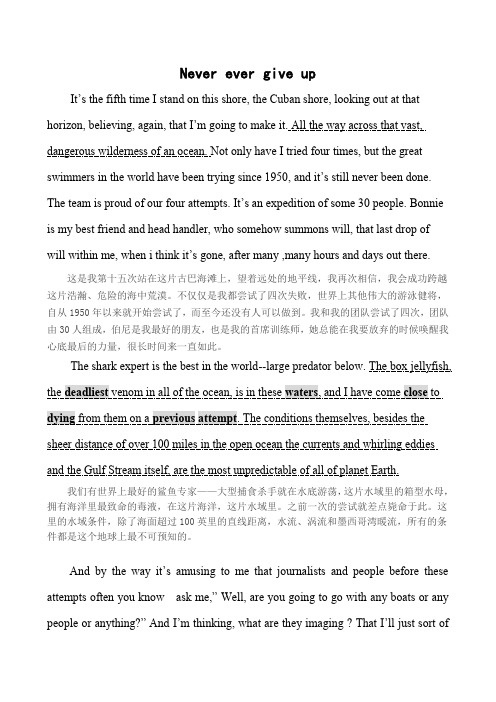
Never ever give upAnd by the way it‟s amusing to me that journalists and people before these attempts often you know ask me,” Well, are you going to go with any boats or any people or anything?” And I‟m thinking, what are they imaging ? That I‟ll just sort ofdo some celestial navigation, and carry a bowie knife in my mouth, and I‟ll hunt fish and skin them alive and eat them, and maybe drag a desalinization plant behind me for fresh water. Yes I have a team. And the team is expert, and the team is courageous, and brimming with innovation and scientific discovery, as it‟s true with any major expedition on the planet.But the journey itself was worthwhile taking. And at this point, by this summer, everybody, scientists, sports scientists, endurance experts, neurologists, my own team, Bonnie said it‟s impossible. It‟s just simply can‟t be done,and Bonnie said to me,”But you‟re going to take the journey, I‟m going to see you through to the end of it, so I‟ll be there.”And now we‟re there.但是这个过程本身依然值得去经历,在这个时候,这个夏天,每个人,科学家、运动科学家、耐力专家、精神科专家、我的团队、伯尼都说这不可能,这就是不可能的完成的任务。
ted演讲稿中英文3分钟

ted演讲稿中英文3分钟尊敬的各位听众:大家好!今天,我非常荣幸能够站在这里,与大家分享一些我内心深处的想法和感悟。
在我们生活的这个世界里,每一天都充满了无数的机遇和挑战。
我们在追寻梦想的道路上不断前行,有时会遇到挫折,有时会收获成功。
但无论如何,我们都不能停止探索和成长的脚步。
我想问大家一个问题:你们有没有过那种一瞬间,突然意识到自己正在做的事情并不是真正想要的?也许是一份工作,也许是一种生活方式。
我曾经就有过这样的经历。
几年前,我在一家知名企业工作,拥有着不错的薪水和稳定的职位。
在外人看来,我的生活似乎完美无缺。
然而,只有我自己知道,内心深处的那份空虚和迷茫。
每天重复着相同的工作,面对着无尽的压力和竞争,我渐渐失去了对生活的热情。
直到有一天,我决定放下一切,重新寻找真正属于自己的道路。
这个决定并不容易,因为它意味着要离开舒适区,面对未知的风险和困难。
但我知道,如果不做出改变,我将永远无法实现内心的渴望。
在探索的过程中,我遇到了许多志同道合的人。
他们来自不同的背景,有着不同的经历,但都怀揣着一颗追求梦想的心。
我们互相鼓励,互相支持,一起度过了许多艰难的时刻。
我发现,当我们勇敢地面对自己的内心,追随自己的热情时,生活就会变得无比精彩。
我们不再被外界的声音所左右,而是专注于自己真正想要的东西。
然而,实现梦想的道路并非一帆风顺。
我们会遇到各种各样的阻碍和困难。
有时候,我们甚至会怀疑自己的选择是否正确。
但正是这些挫折和困难,让我们变得更加坚强和成熟。
就像爬山一样,在攀登的过程中,我们会感到疲惫和痛苦。
但当我们终于登上山顶,俯瞰着脚下的美景时,所有的付出都变得值得。
所以,亲爱的朋友们,不要害怕去追求自己的梦想。
无论它看起来多么遥不可及,只要我们坚持不懈地努力,就一定能够实现。
最后,我想用一句话来结束我的演讲:“人生没有彩排,每一天都是现场直播。
”让我们珍惜每一个瞬间,勇敢地去追求自己的梦想,创造一个属于我们自己的精彩人生!Thank you all for listening!尊敬的各位听众:大家好!能站在这个舞台上,与你们交流,我感到无比的激动和幸运。
ted演讲稿中英对照励志

ted演讲稿中英对照励志ted经典励志演讲稿有哪些?搜集了ted的经典中英文对照演讲稿大全,有中文是不是看的更加流畅呢?一起来看看。
As you slowly open your eyes,look around,notice where the light es into your room; listen carefully,see if there are new sounds you can recognize; feel with your body and spirit,and see if you can sense the freshness in the air.Yes,yes,yes,it’s a new day,it’s a different day,and it’s a bright day!And most importantly,it’s a new beginning for your life,a beginning where you are going to make new decisions,take new actions,make new friends,and take your life to a totally unprecedented level.In your mind’s eye,you can see clearly the things you want to have,the paces you intend to go,the relationships you desire to develop,and the positions you aspire to reach.You can hear your laughters of joy and happiness on the day when everything happens as you dream.You can see the smiles on the people around you when the magic moment strikes.You can feel your face is getting red,your heart is beating fast,and your blood is rushing all over yourbody,to every single corner of your being!You know all this is real as long as you areconfident,passionate and mitted!And you are confident,you are passionate,you are mitted!You will no longer fear making new sounds,showing new facial expressions,using your body in new ways,approaching new people,and asking new questions.You will live every single day of your life with absolute passion,and you will show your passion through the words you speak and the actions you take.You will focus all your time and effort on the most important goals of your life.You will never suumb to challenges of hardships.You will never waver in your pursuit ofexcellence.After all,you are the best,and you deserve the best!As your coach and friend,I can assure you the door to all the best things in the world will open to you,but the key to that door is in your hand.You must do your part.You must faithfully follow the plans you make and take the actions you plan; you must never quit and you must never fear.I know you must do it,you can do it,you will do it,and you will sueed!Now stand firm and tall,make a fist,get excited,and yell it out:I must do it!I can do it!I will do it!I will sueed!I must do it!I can do it!I will do it!I will sueed!I must do it!I can do it!I will do it!I will sueed!当你慢慢睁开眼睛,环顾四周,注意到光线进入你的房间;仔细聆听,看看是否有新的声音你能认出;感受你的身体和精神,看看你是否能感觉到新鲜的空气。
英语ted演讲稿中英文

英语ted演讲稿中英文以下是聘才小编为大家搜索整理的,欢迎大家阅读。
英语ted演讲稿中英文When I was nine years old I went off to summer camp for the first time. And my mother packed me a suitcase full of books, which to me seemed like a perfectly natural thing to do. Because in my family, reading was the primary group activity. And this might sound antisocial to you, but for us it was really just a different way of being social. You have the animal warmth of your family sitting right next to you, but you are also free to go roaming around the adventureland inside your own mind. And I had this idea that camp was going to be just like this, but better. (Laughter) I had a vision of 10 girls sitting in a cabin cozily reading books in their matching nightgowns.当我九岁的时候我第一次去参加夏令营我妈妈帮我整理好了我的行李箱里面塞满了书这对于我来说是一件极为自然的事情因为在我的家庭里阅读是主要的家庭活动听上去你们可能觉得我们是不爱交际的但是对于我的家庭来说这真的只是接触社会的另一种途径你们有自己家庭接触时的温暖亲情家人静坐在你身边但是你也可以自由地漫游在你思维深处的冒险乐园里我有一个想法野营会变得像这样子,当然要更好些 (笑声) 我想象到十个女孩坐在一个小屋里都穿着合身的女式睡衣惬意地享受着读书的过程(Laughter)(笑声)Camp was more like a keg party without any alcohol. And on the very first day our counselor gathered us all together and she taught us a cheer that she said we would be doing every day for the rest of the summer to instill camp spirit. And it went like this: "R-O-W-D-I-E, that's the way we spell rowdie. Rowdie, rowdie, let's get rowdie." Yeah. So I couldn't figure out for the life of me why we were supposed to be so rowdy, or why we had to spell this word incorrectly. (Laughter) But I recited a cheer. I recited a cheer along with everybody else. I did my best. And I just waited for the time that I could go off and read my books.野营这时更像是一个不提供酒水的派对聚会在第一天的时候呢我们的顾问把我们都集合在一起并且她教会了我们一种今后要用到的庆祝方式在余下夏令营的每一天中让“露营精神”浸润我们之后它就像这样继续着R-O-W-D-I-E 这是我们拼写“吵闹"的口号我们唱着“噪音,喧闹,我们要变得吵一点”对,就是这样可我就是弄不明白我的生活会是什么样的为什么我们变得这么吵闹粗暴或者为什么我们非要把这个单词错误地拼写 (笑声) 但是我可没有忘记庆祝。
翻译版How to Live Before You Die(乔布斯演讲)

How to Live Before You Die死前如何生活By Steve Jobs, delivered on June 12, 2005由史蒂夫·乔布斯于2005年6月12日交付I am honored to be with you today at your commencement from one of the finest universities in the world. I never graduated from college. Truth be told, this is the closest I've ever gotten to a college graduation. Today I want to tell you three stories from my life. That's it. No big deal. Just three stories.我很荣幸今天能和你们一起参加世界上最好的大学之一的毕业典礼。
我从来没有大学毕业。
说实话,这是我离大学毕业最近的一刻。
今天我想告诉你们我生命中的三个故事。
够了就要这些。
有什么了不起!只有三个故事。
The first story is about connecting the dots.第一个故事是关于连接点。
I dropped out of Reed College after the first 6 months, but then stayed around as a drop-in for another 18 months or so before I really quit. So why did I drop out?我在里德学院学习了6个月后就退学了,但是在我真正退学之前,我又在学校待了18个月左右。
那我为什么退学呢?It started before I was born. My biological mother was a young, unwed college graduate student, and she decided to put me up for adoption. She felt very strongly that I should be adopted by college graduates, so everything was all set for me to be adopted at birth by a lawyer and his wife. Except that when I popped out they decided at the last minute that they really wanted a girl. So my parents, who were on a waiting list, got a call in the middle of the night asking: "We have an unexpected baby boy; do you want him?" They said: "Of course." My biological mother later found out that my mother had never graduated from college and that my father had never graduated from high school. She refused to sign the final adoption papers. She only relented a few months later when my parents promised that I would someday go to college. 它在我出生之前就开始了。
Ted演讲Candy Chang:Before I die I want to中英
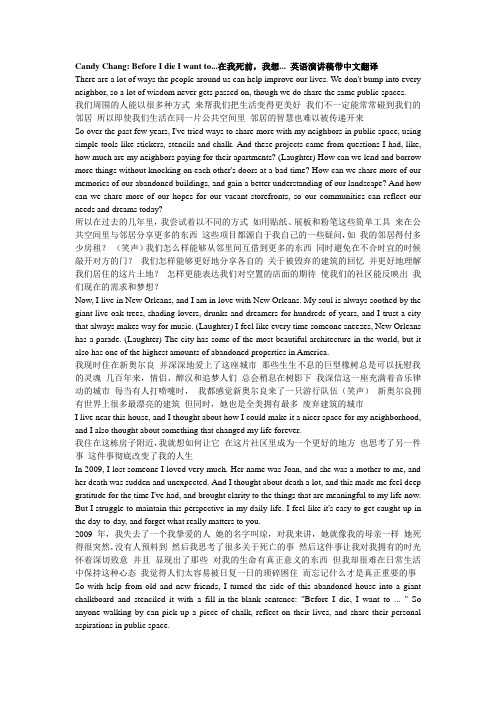
Candy Chang: Before I die I want to...在我死前,我想... 英语演讲稿带中文翻译There are a lot of ways the people around us can help improve our lives. We don't bump into every neighbor, so a lot of wisdom never gets passed on, though we do share the same public spaces.我们周围的人能以很多种方式来帮我们把生活变得更美好我们不一定能常常碰到我们的邻居所以即使我们生活在同一片公共空间里邻居的智慧也难以被传递开来So over the past few years, I've tried ways to share more with my neighbors in public space, using simple tools like stickers, stencils and chalk. And these projects came from questions I had, like, how much are my neighbors paying for their apartments? (Laughter) How can we lend and borrow more things without knocking on each other's doors at a bad time? How can we share more of our memories of our abandoned buildings, and gain a better understanding of our landscape? And how can we share more of our hopes for our vacant storefronts, so our communities can reflect our needs and dreams today?所以在过去的几年里,我尝试着以不同的方式如用贴纸、展板和粉笔这些简单工具来在公共空间里与邻居分享更多的东西这些项目都源自于我自己的一些疑问,如我的邻居得付多少房租?(笑声)我们怎么样能够从邻里间互借到更多的东西同时避免在不合时宜的时候敲开对方的门?我们怎样能够更好地分享各自的关于被毁弃的建筑的回忆并更好地理解我们居住的这片土地?怎样更能表达我们对空置的店面的期待使我们的社区能反映出我们现在的需求和梦想?Now, I live in New Orleans, and I am in love with New Orleans. My soul is always soothed by the giant live oak trees, shading lovers, drunks and dreamers for hundreds of years, and I trust a city that always makes way for music. (Laughter) I feel like every time someone sneezes, New Orleans has a parade. (Laughter) The city has some of the most beautiful architecture in the world, but it also has one of the highest amounts of abandoned properties in America.我现时住在新奥尔良并深深地爱上了这座城市那些生生不息的巨型橡树总是可以抚慰我的灵魂几百年来,情侣、醉汉和追梦人们总会稍息在树影下我深信这一座充满着音乐律动的城市每当有人打喷嚏时,我都感觉新奥尔良来了一只游行队伍(笑声)新奥尔良拥有世界上很多最漂亮的建筑但同时,她也是全美拥有最多废弃建筑的城市I live near this house, and I thought about how I could make it a nicer space for my neighborhood, and I also thought about something that changed my life forever.我住在这栋房子附近,我就想如何让它在这片社区里成为一个更好的地方也思考了另一件事这件事彻底改变了我的人生In 2009, I lost someone I loved very much. Her name was Joan, and she was a mother to me, and her death was sudden and unexpected. And I thought about death a lot, and this made me feel deep gratitude for the time I've had, and brought clarity to the things that are meaningful to my life now. But I struggle to maintain this perspective in my daily life. I feel like it's easy to get caught up in the day-to-day, and forget what really matters to you.2009年,我失去了一个我挚爱的人她的名字叫琼,对我来讲,她就像我的母亲一样她死得很突然,没有人预料到然后我思考了很多关于死亡的事然后这件事让我对我拥有的时光怀着深切致意并且显现出了那些对我的生命有真正意义的东西但我却很难在日常生活中保持这种心态我觉得人们太容易被日复一日的琐碎困住而忘记什么才是真正重要的事So with help from old and new friends, I turned the side of this abandoned house into a giant chalkboard and stenciled it with a fill-in-the-blank sentence: "Before I die, I want to ... " So anyone walking by can pick up a piece of chalk, reflect on their lives, and share their personal aspirations in public space.我于是在一些新老朋友的帮助下把这栋废弃的房子的一面墙做成了一个巨型黑板我在上面写满了同一道填空题“在死之前,我想??” 所以每一个路过的人都可以捡起一根粉笔在公共场合里留下一些他们人生的痕迹且来分享他们内心深处的愿望I didn't know what to expect from this experiment, but by the next day, the wall was entirely filled out, and it kept growing. And I'd like to share a few things that people wrote on this wall.我并不知道该从这个实验里期待些什么但是第二天,整个墙壁都被填满了而且不断有人添加新的答案我想跟大家分享一些人们在那面墙上写的东西"Before I die, I want to be tried for piracy." (Laughter) "Before I die, I want to straddle the International Date Line." "Before I die, I want to sing for millions." "Before I die, I want to plant a tree." "Before I die, I want to live off the grid." "Before I die, I want to hold her one more time." "Before I die, I want to be someone's cavalry." "Before I die, I want to be completely myself." “在死之前,我想为我的海盗行为接受审判”(笑声)“在死之前,我想跨过国际日期变更线” “在死之前,我想在上百万的观众面前唱歌” “在死之前,我想种一棵树” “在死之前,我想过隐居的生活” “在死之前,我想再抱她一次” “在死之前,我想成为某个人的骑士” “在死之前,我想要做完全真实的自己”So this neglected space became a constructive one, and people's hopes and dreams made me laugh out loud, tear up, and they consoled me during my own tough times. It's about knowing you're not alone. It's about understanding our neighbors in new and enlightening ways. It's about making space for reflection and contemplation, and remembering what really matters most to us as we grow and change.这个本来被遗忘的建筑变成了一个极具建设性的地方这些人的希望和梦想让我放声大笑,也黯然落泪也曾在我经历困境的时候给我安慰这让我们相信自己并不孤单让我们对邻居有了全新的启发心智的了解这为我们营造了一个反省和思考的空间也提醒我们在不断成长改变的过程中什么才是最为重要的I made this last year, and started receiving hundreds of messages from passionate people who wanted to make a wall with their community, so my civic center colleagues and I made a tool kit, and now walls have been made in countries around the world, including Kazakhstan, South Africa, Australia, Argentina and beyond. Together, we've shown how powerful our public spaces can be if we're given the opportunity to have a voice and share more with one another.这个黑板是我去年做的,然后我就不断收到一些热情的人们给我发的信息说想在他们的社区里也设立一面这样的墙壁所以我和我的同事们就做了一个小型工具箱现在,这面墙壁已经遍布全球包括哈萨克斯坦,南非澳大利亚阿根廷等地这些迹象表明,如果我们能有一个表达自己的意愿并与他人分享的机会那么公共空间将发挥巨大的作用Two of the most valuable things we have are time and our relationships with other people. In our age of increasing distractions, it's more important than ever to find ways to maintain perspective and remember that life is brief and tender. Death is something that we're often discouraged to talk about or even think about, but I've realized that preparing for death is one of the most empowering things you can do. Thinking about death clarifies your life.我们所拥有的最珍贵的两样东西,一个是时间还有一个,是与他人的联系在这个物欲横流的时代里努力坚持自我,铭记人生的短暂与生命的脆弱变得比以往任何时代都更重要我们总是没有勇气谈论死亡甚至没有勇气去想着死亡但是我意识到,为死亡做心理准备是我们能够做到的最有力的事情之一思考死亡能够让你对自己的人生有更清醒的认识Our shared spaces can better reflect what matters to us as individuals and as a community, and with more ways to share our hopes, fears and stories, the people around us can not only help usmake better places, they can help us lead better lives. Thank you. (Applause)公共空间可以更好的体现到底什么对我们是真正重要的无论是对个人来说或者对于整个社区来说有了更多的方式来分享我们的希望,恐惧和经历我们身边的人不仅能够帮助我们创造更美好的地方更帮助我们过上更美好的生活谢谢(掌声)(Applause) Thank you. (Applause) (Applause)(掌声)谢谢(掌声)(掌声)。
TED演讲 向死而生 20160302 内含中英文对照演讲稿
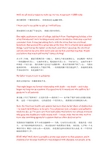
Well, we all need a reason to wake up. For me, it just took 11,000 volts.我们都需要一个醒来的理由。
对我来说是11,000伏特。
I know you're too polite to ask, so I will tell you.我知道你们太礼貌了不会过问,那就让我告诉你们。
One night, sophomore year of college, just back from Thanksgiving holiday, a few of my friends and I were horsing around, and we decided to climb atop a parked commuter train. It was just sitting there, with the wires that run overhead. Somehow, that seemed like a great idea at the time. We'd certainly done stupider things. I scurried up the ladder on the back, and when I stood up, the electrical current entered my arm, blew down and out my feet, and that was that. Would you believe that watch still works? Takes a licking!在大学二年级,感恩节假期后的一天晚上,我和几个朋友闹着玩儿,决定爬到一列停在一旁的通勤列车顶上。
它就停在那儿,缆线就在车顶上方。
不知为什么,这似乎在那个时候是一个好主意。
我们的确干过比这个还傻的事。
我从后面的梯子窜了上去,当我站起来的时候,一股电流进入了我的手臂,一直到我的脚下然后就这样了。
TED演讲:你就是你,你是最重要的,直到你生命的最后一刻

TED演讲:你就是你,你是最重要的,直到你生命的最后一刻在全球抗击新冠疫情的大背景下,第1整理术希望与大家坦诚地聊聊生命与死亡。
今天分享澳洲ICU医生Peter Saul的演讲《Dying in the 21st Century》。
他说,我们每个人都将在21世纪死亡,所以必须认真严肃地谈谈这个话题。
编辑 | 第1整理术编辑部读者投稿|*******************1第1整理术YiOrganizer内容摘录▪我们8个人里面就会有1个人认为自己会长生不老。
▪他们当中只有1%的人,对他们生理死亡后的事有计划。
只有500分之一的老人,会对他们病重时有应对计划。
▪我们大家都知道的是,很明显,我们都会死去。
但我们以何种方式死去更重要。
很明显,这不仅对我们重要。
这对那些活着的人也很重要。
▪10个人里面就有一个会死在ICU。
而在美国,这个数字是每5个人当中有1个。
在迈阿密,这个数字是每5个人当中有3个。
▪21世纪主要有四种死亡形式。
我们所有人都会以其中的一种形式死去。
越来越引起我们关注的一种死亡方式,猝死现在已经很少见的。
癌症在年轻人身上越来越高。
现在80岁年龄的人只有10%死于癌症。
造成死亡最多的因素,主要是以下几个方面:越来越多的人死于器官功能衰竭,如呼吸和心、肾功能衰竭等。
▪我们见过最多的案例,每10个在这里听演讲的人中就会有6个,就用这个方式中介。
脆弱(功能缺失),世界上,是现代人死亡的主要原因。
▪不幸的是,延长生命,延长的不是青春,而是老年的时光。
▪我喜欢这张克利姆特的画。
这是因为,你越看它,你越能了解发生在这里的一切。
▪我认为,在我们决定走上去ICU这条路时,我们是否真的想死在ICU吗?▪我有一个小主意,和那些慢慢变老的人谈一谈。
你可以为此做一些事情。
▪你只需要问一个简单的问题。
这是一个很有用的问题。
:“万一你病得不能说话了,你想让谁代表你的心声呢?” 这是一个很重要的问题。
这是因为给予谁这个权利,就会给你带来不同的结果。
Ted演讲Candy Chang:Before I die I want to中英

Candy Chang: Before I die I want to...在我死前,我想... 英语演讲稿带中文翻译There are a lot of ways the people around us can help improve our lives. We don't bump into every neighbor, so a lot of wisdom never gets passed on, though we do share the same public spaces.我们周围的人能以很多种方式来帮我们把生活变得更美好我们不一定能常常碰到我们的邻居所以即使我们生活在同一片公共空间里邻居的智慧也难以被传递开来So over the past few years, I've tried ways to share more with my neighbors in public space, using simple tools like stickers, stencils and chalk. And these projects came from questions I had, like, how much are my neighbors paying for their apartments? (Laughter) How can we lend and borrow more things without knocking on each other's doors at a bad time? How can we share more of our memories of our abandoned buildings, and gain a better understanding of our landscape? And how can we share more of our hopes for our vacant storefronts, so our communities can reflect our needs and dreams today?所以在过去的几年里,我尝试着以不同的方式如用贴纸、展板和粉笔这些简单工具来在公共空间里与邻居分享更多的东西这些项目都源自于我自己的一些疑问,如我的邻居得付多少房租?(笑声)我们怎么样能够从邻里间互借到更多的东西同时避免在不合时宜的时候敲开对方的门?我们怎样能够更好地分享各自的关于被毁弃的建筑的回忆并更好地理解我们居住的这片土地?怎样更能表达我们对空置的店面的期待使我们的社区能反映出我们现在的需求和梦想?Now, I live in New Orleans, and I am in love with New Orleans. My soul is always soothed by the giant live oak trees, shading lovers, drunks and dreamers for hundreds of years, and I trust a city that always makes way for music. (Laughter) I feel like every time someone sneezes, New Orleans has a parade. (Laughter) The city has some of the most beautiful architecture in the world, but it also has one of the highest amounts of abandoned properties in America.我现时住在新奥尔良并深深地爱上了这座城市那些生生不息的巨型橡树总是可以抚慰我的灵魂几百年来,情侣、醉汉和追梦人们总会稍息在树影下我深信这一座充满着音乐律动的城市每当有人打喷嚏时,我都感觉新奥尔良来了一只游行队伍(笑声)新奥尔良拥有世界上很多最漂亮的建筑但同时,她也是全美拥有最多废弃建筑的城市I live near this house, and I thought about how I could make it a nicer space for my neighborhood, and I also thought about something that changed my life forever.我住在这栋房子附近,我就想如何让它在这片社区里成为一个更好的地方也思考了另一件事这件事彻底改变了我的人生In 2009, I lost someone I loved very much. Her name was Joan, and she was a mother to me, and her death was sudden and unexpected. And I thought about death a lot, and this made me feel deep gratitude for the time I've had, and brought clarity to the things that are meaningful to my life now. But I struggle to maintain this perspective in my daily life. I feel like it's easy to get caught up in the day-to-day, and forget what really matters to you.2009年,我失去了一个我挚爱的人她的名字叫琼,对我来讲,她就像我的母亲一样她死得很突然,没有人预料到然后我思考了很多关于死亡的事然后这件事让我对我拥有的时光怀着深切致意并且显现出了那些对我的生命有真正意义的东西但我却很难在日常生活中保持这种心态我觉得人们太容易被日复一日的琐碎困住而忘记什么才是真正重要的事So with help from old and new friends, I turned the side of this abandoned house into a giant chalkboard and stenciled it with a fill-in-the-blank sentence: "Before I die, I want to ... " So anyone walking by can pick up a piece of chalk, reflect on their lives, and share their personal aspirations in public space.我于是在一些新老朋友的帮助下把这栋废弃的房子的一面墙做成了一个巨型黑板我在上面写满了同一道填空题“在死之前,我想??” 所以每一个路过的人都可以捡起一根粉笔在公共场合里留下一些他们人生的痕迹且来分享他们内心深处的愿望I didn't know what to expect from this experiment, but by the next day, the wall was entirely filled out, and it kept growing. And I'd like to share a few things that people wrote on this wall.我并不知道该从这个实验里期待些什么但是第二天,整个墙壁都被填满了而且不断有人添加新的答案我想跟大家分享一些人们在那面墙上写的东西"Before I die, I want to be tried for piracy." (Laughter) "Before I die, I want to straddle the International Date Line." "Before I die, I want to sing for millions." "Before I die, I want to plant a tree." "Before I die, I want to live off the grid." "Before I die, I want to hold her one more time." "Before I die, I want to be someone's cavalry." "Before I die, I want to be completely myself." “在死之前,我想为我的海盗行为接受审判”(笑声)“在死之前,我想跨过国际日期变更线” “在死之前,我想在上百万的观众面前唱歌” “在死之前,我想种一棵树” “在死之前,我想过隐居的生活” “在死之前,我想再抱她一次” “在死之前,我想成为某个人的骑士” “在死之前,我想要做完全真实的自己”So this neglected space became a constructive one, and people's hopes and dreams made me laugh out loud, tear up, and they consoled me during my own tough times. It's about knowing you're not alone. It's about understanding our neighbors in new and enlightening ways. It's about making space for reflection and contemplation, and remembering what really matters most to us as we grow and change.这个本来被遗忘的建筑变成了一个极具建设性的地方这些人的希望和梦想让我放声大笑,也黯然落泪也曾在我经历困境的时候给我安慰这让我们相信自己并不孤单让我们对邻居有了全新的启发心智的了解这为我们营造了一个反省和思考的空间也提醒我们在不断成长改变的过程中什么才是最为重要的I made this last year, and started receiving hundreds of messages from passionate people who wanted to make a wall with their community, so my civic center colleagues and I made a tool kit, and now walls have been made in countries around the world, including Kazakhstan, South Africa, Australia, Argentina and beyond. Together, we've shown how powerful our public spaces can be if we're given the opportunity to have a voice and share more with one another.这个黑板是我去年做的,然后我就不断收到一些热情的人们给我发的信息说想在他们的社区里也设立一面这样的墙壁所以我和我的同事们就做了一个小型工具箱现在,这面墙壁已经遍布全球包括哈萨克斯坦,南非澳大利亚阿根廷等地这些迹象表明,如果我们能有一个表达自己的意愿并与他人分享的机会那么公共空间将发挥巨大的作用Two of the most valuable things we have are time and our relationships with other people. In our age of increasing distractions, it's more important than ever to find ways to maintain perspective and remember that life is brief and tender. Death is something that we're often discouraged to talk about or even think about, but I've realized that preparing for death is one of the most empowering things you can do. Thinking about death clarifies your life.我们所拥有的最珍贵的两样东西,一个是时间还有一个,是与他人的联系在这个物欲横流的时代里努力坚持自我,铭记人生的短暂与生命的脆弱变得比以往任何时代都更重要我们总是没有勇气谈论死亡甚至没有勇气去想着死亡但是我意识到,为死亡做心理准备是我们能够做到的最有力的事情之一思考死亡能够让你对自己的人生有更清醒的认识Our shared spaces can better reflect what matters to us as individuals and as a community, and with more ways to share our hopes, fears and stories, the people around us can not only help usmake better places, they can help us lead better lives. Thank you. (Applause)公共空间可以更好的体现到底什么对我们是真正重要的无论是对个人来说或者对于整个社区来说有了更多的方式来分享我们的希望,恐惧和经历我们身边的人不仅能够帮助我们创造更美好的地方更帮助我们过上更美好的生活谢谢(掌声)(Applause) Thank you. (Applause) (Applause)(掌声)谢谢(掌声)(掌声)。
TED演讲:在死之前,我想......

TED演讲:在死之前,我想......导语在全球抗击新冠疫情的大背景下,第1整理术希望与大家坦诚地聊聊生命与死亡。
今天我们分享一则TED演讲《Before I die》,讲者Candy Chang鼓励路人写下一件毕生想要完成的事。
没想到,这个运动引发全球民众效仿。
编辑 | 第1整理术编辑部读者投稿|*******************视频只有6分钟,句句精彩,非常值得一看!主讲人的英文发音,好听到能让你的耳朵吃冰激凌!1第1整理术YiOrganizer内容摘录2009年,我失去了一个我挚爱的人。
她的名字叫琼。
对我来讲,她就像我的母亲一样。
她死得很突然,没有人预料到。
然后我思考了很多有关死亡的事。
这件事让我对我拥有的时光,怀着深切致意,并开始寻找对与我的生命真正有意义的东西。
我觉得人们太容易被日常琐事困住,而忘记什么才是真正重要的事。
我在上面写满了同一道填空题:在死之前,我想......(Before I die, I want to)在死之前,我想在上百万观众前面唱歌在死之前,我想种一棵树在死之前,我想过隐居的生活在死之前,我想再抱她一次在死之前,我想成为某个人的骑士在死之前,我想要做完全真实的自己这些人的希望,梦想,让我放声大笑,也黯然落泪,也曾在我精力困境的时候给我安慰。
这位我们营造了一个反思和思考的空间,也提醒我们在不断成长改变的过程中,什么才是最重要的。
如果我们能有一个表达自己的意愿,并与他人分享的机会,那么公共空间将发挥巨大的作用。
我们所拥有的最珍贵的两样东西,一个是时间,还有一个,是与他人的联系。
在这个物欲横流的时代里,努力坚持自我,铭记人生的短暂和生命的脆弱,变得比以往任何时代都更重要。
我们总是没有勇气谈论死亡,甚至没有勇气想着死亡。
但是我意识到,为死亡做心理准备,是我们能够做到的最有力量的事情之一。
思考死亡能够让你对自己的人生有更清醒的认知。
当我们有了更多的方式,来分享我们的希望、恐惧和精力,我们身边的人不仅能帮助我们创造更美好的地方,更帮助我们过上更美好的生活。
Ted中英文双语演讲稿

活在世上做好自己足矣"I used to think the worst thing in life was to end up all alone.“我曾经认为生活中最糟糕的事情就是孤独终老。
It's not.并不是。
The worst thing in life is to end up with people that make you feel all alone." --Robin Williams生活中最糟糕的事情就是和让你感到孤独的人在一起。
”——罗宾·威廉姆斯Codependency is a potentially destructive state to be in.相互依赖是一种潜在的破坏性状态。
At its core, it means that you cannot be alone.本质上,这意味着你无法独处。
And the consequence of this is an ongoing clinging to other people; no matter how bad they treat you. 这样做的结果就是你会持续地依附于他人,不管他们对你有多坏。
But it's an illusion to think that we need someone else to make us feel complete.但是认为我们需要别人来让我们感到完整是一种错觉。
We don't.我们不需要。
When we let our contentment depend on external things, we have given our power away.当我们让自己的满足依赖于外在的东⻄时,我们已经失去了自己的力量。
As humans, we aren't islands.作为人类,我们不是岛屿。
TED英文演讲:性命无尽,一往无前
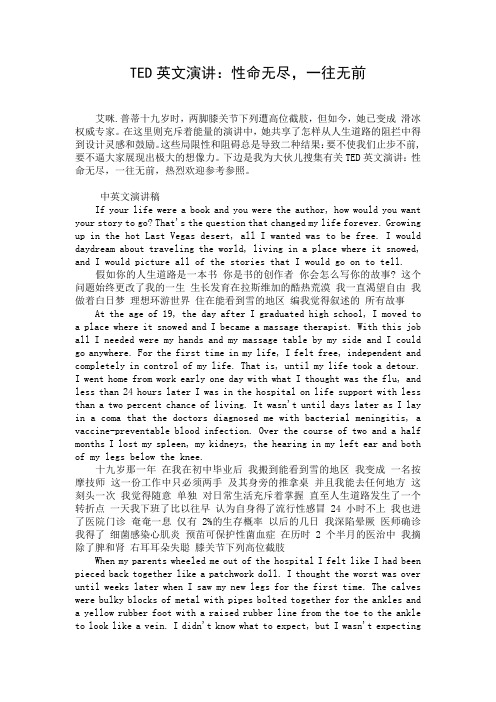
TED英文演讲:性命无尽,一往无前艾咪.普蒂十九岁时,两脚膝关节下列遭高位截肢,但如今,她已变成滑冰权威专家。
在这里则充斥着能量的演讲中,她共享了怎样从人生道路的阻拦中得到设计灵感和鼓励。
这些局限性和阻碍总是导致二种结果:要不使我们止步不前,要不逼大家展现出极大的想像力。
下边是我为大伙儿搜集有关TED英文演讲:性命无尽,一往无前,热烈欢迎参考参照。
中英文演讲稿If your life were a book and you were the author, how would you want your story to go? That's the question that changed my life forever. Growing up in the hot Last Vegas desert, all I wanted was to be free. I would daydream about traveling the world, living in a place where it snowed, and I would picture all of the stories that I would go on to tell.假如你的人生道路是一本书你是书的创作者你会怎么写你的故事? 这个问题始终更改了我的一生生长发育在拉斯维加的酷热荒漠我一直渴望自由我做着白日梦理想环游世界住在能看到雪的地区编我觉得叙述的所有故事At the age of 19, the day after I graduated high school, I moved to a place where it snowed and I became a massage therapist. With this job all I needed were my hands and my massage table by my side and I could go anywhere. For the first time in my life, I felt free, independent and completely in control of my life. That is, until my life took a detour.I went home from work early one day with what I thought was the flu, and less than 24 hours later I was in the hospital on life support with less than a two percent chance of living. It wasn't until days later as I lay in a coma that the doctors diagnosed me with bacterial meningitis, a vaccine-preventable blood infection. Over the course of two and a half months I lost my spleen, my kidneys, the hearing in my left ear and both of my legs below the knee.十九岁那一年在我在初中毕业后我搬到能看到雪的地区我变成一名按摩技师这一份工作中只必须两手及其身旁的推拿桌并且我能去任何地方这刻头一次我觉得随意单独对日常生活充斥着掌握直至人生道路发生了一个转折点一天我下班了比以往早认为自身得了流行性感冒 24小时不上我也进了医院门诊奄奄一息仅有2%的生存概率以后的几日我深陷晕厥医师确诊我得了细菌感染心肌炎预苗可保护性菌血症在历时2个半月的医治中我摘除了脾和肾右耳耳朵失聪膝关节下列高位截肢When my parents wheeled me out of the hospital I felt like I had been pieced back together like a patchwork doll. I thought the worst was over until weeks later when I saw my new legs for the first time. The calves were bulky blocks of metal with pipes bolted together for the ankles and a yellow rubber foot with a raised rubber line from the toe to the ankle to look like a vein. I didn't know what to expect, but I wasn't expectingthat.当爸爸妈妈将我发布医院门诊时我觉得自身被再次拼接起來像一个拼毛绒娃娃原以为悲催的事已完成直至我第一次看到自身的新腿小腿肚是沉重的金属材料块脚裸用管道和螺钉固定不动另加淡黄色的硫化橡胶脚凸起的橡胶线从脚指头拓宽到脚裸为了更好地使他们看上去像毛细血管我也不知道我要的結果是啥但绝对不会是这一With my mom by my side and tears streaming down our faces, I strapped on these chunky legs and I stood up. They were so painful and so confining that all I could think was, how am I ever going to travel the world in these things? How was I ever going to live the life full of adventure and stories, as I always wanted? And how was I going to snowboard again?母亲立在我边上两人眼泪肆无忌惮我绑上这两根粗小短腿随后站立起来他们要我觉得十分痛楚,而且充斥着限定我脑中只有一个念头:用这种破东西我怎能环游世界? 我怎样才可以过我一直要想的绚丽多姿的日常生活?That day, I went home, I crawled into bed and this is what my life looked like for the next few months: me passed out, escaping from reality, with my legs resting by my side. I was absolutely physically and emotionally broken.我怎样才可以再玩滑雪? 那一天,我回到家,爬发生关系这是我下面好多个月的生活状态: 我在床上, 退出日常生活逃出实际我的腿放到床前.我还在生理学上和心理状态上彻底崩溃了But I knew that in order to move forward, I had to let go of the old Amy and learn to embrace the new Amy. And that is when it dawned on me that I didn't have to be five-foot-five anymore. I could be as tall as I wanted! (Laughter) (Applause) Or as short as I wanted, depending on who I was dating. (Laughter) And if I snowboarded again, my feet aren't going to get cold. (Laughter) And best of all, I thought, I can make my feet the size of all the shoes that are on the sales rack. (Laughter) And I did! So there were benefits here.可是我明白为了更好地往前走我务必放宽以往的格蕾斯学着接纳新的格蕾斯那时候我忽然想起我再也不仅有 5.5英尺高了我能想多大有多大 (欢笑声)(欢呼声) 或是想多矮有多矮这得看我与谁幽会 (欢笑声) 假如再玩滑雪脚再也不能冷 (欢笑声) 我认为最赞的是我能调节脚的尺寸来合适仓储货架上一切码数的鞋 (欢笑声) 我真是那麼做了! 因此这或是有一些益处的It was this moment that I asked myself that life-defining question: If my life were a book and I were the author, how would I want the story to go? And I began to daydream. I daydreamed like I did as a little girl and I imagined myself walking gracefully, helping other people through my journey and snowboarding again. And I didn't just see myself carving down a mountain of powder, I could actually feel it. I could feel the wind against my face and the beat of my racing heart as if it were happening in that very moment. And that is when a new chapter in my life began.那一刻我问了自身一个决策人生道路迈向的难题假如人生道路是一本书可是我是创作者我会怎么写这个故事? 我逐渐做白日梦想儿时那般作梦我想像自身雅致地向前在路程中帮助他人再度玩滑雪我并并不是只是见到自身从山顶滑下去我能真切感遭受那一个情景我能感受到风迎面而来感受到心血管的律动好似那一刻已经真正产生.那就是我打开人生道路新的篇章的時刻Four months later I was back up on a snowboard, although things didn't go quite as expected: My knees and my ankles wouldn't bend and at one point I traumatized all the skiers on the chair lift when I fell and my legs, still attached to my snowboard — (Laughter) — went flying down the mountain, and I was on top of the mountain still. I was so shocked, I was just as shocked as everybody else, and I was so discouraged, but I knew that if I could find the right pair of feet that I would be able to do this again. And this is when I learned that our borders and our obstacles can only do two things: one, stop us in our tracks or two, force us to get creative.4个月以后,我拾起滑雪尽管事儿并并不像我希望的那般我的膝关节和脚裸没法弯折在某一点上我吓傻了升降椅上全部的滑雪者 (欢笑声)便是当我们跌倒时,我的腿还连到双翘板 (欢笑声) 他们一起飞落入山脚下而我依旧在峰顶 (欢笑声)把我惊到同别人一样我震惊并且很迷失可是我明白假如我找到了两根适合的腿我彻底能够取得成功这时候我懂得了千难万险只有做2件事:一是将大家困在原先的路轨二是驱使大家充斥着想像力I did a year of research, still couldn't figure out what kind of legs to use, couldn't find any resources that could help me. So I decided to make a pair myself. My leg maker and I put random parts together and we made a pair of feet that I could snowboard in. As you can see, rusted bolts, rubber, wood and neon pink duct tape. And yes, I can change my toenail polish. It was these legs and the best 21st birthday gift I could ever receive —a new kidney from my dad —that allowed me to follow my dreams again. I started snowboarding, then I went back to work, then I went back to school.我科学研究了一年依然不清楚用哪些的腿也找不着一切有效的資源因此我打算自己做一副假腿我与创作者把各种各样构件拼在一起干了两根能够玩滑板的腿你能见到锈蚀的地脚螺栓、硫化橡胶、木材和夜光粉胶布没有错我能换指甲颜色这双假腿及其我二十一岁生日接到的最好礼物————我的爸爸的一个肾要我再度追求梦想.我逐渐玩滑雪我再次工作中并回校Then in 20xx I cofounded a nonprofit organization for youth and young adults with physical disabilities so they could get involved with action sports. From there, I had the opportunity to go to South Africa, where I helped to put shoes on thousands of children's feet so they could attend school.20xx年我创立了一个非盈利组织用于援助人体残废的年青人使她们能再度参与体育竞赛从那以后是我机遇前去巴西给千百少年儿童产生鞋那样她们就可以去上学And just this past February, I won two back-to-back World Cup gold medals —(Applause) —which made me the highest ranked adaptive female snowboarder in the world.在刚以往的二月我陆续获得二块全球冠军 (欢呼声) ——这使我变成世界上最高等级的伤残人女人滑雪选手.Eleven years ago, when I lost my legs, I had no idea what to expect. But if you ask me today, if I would ever want to change my situation, I would have to say no. Because my legs haven't disabled me, if anything they've enabled me. They've forced me to rely on my imagination and to believe in the possibilities, and that's why I believe that our imaginations can be used as tools for breaking through borders, because in our minds, we can do anything and we can be anything.20xx年以前当我们丧失腿时我也不知道该盼望哪些可是假如你如今跟我说是不是想要换一个人生道路我能回应不由于我的两腿并沒有阻拦我假如说他们帮我产生了哪些那便是他们要我借助想像力让我坚信一切皆有可能这就是为何我坚信想像能够变成专用工具用于打破阻碍由于在脑中我们可以做一切事能够变成所有人It's believing in those dreams and facing our fears head-on that allows us to live our lives beyond our limits. And although today is about innovation without borders, I have to say that in my life, innovation has only been possible because of my borders. I've learned that borders are where the actual ends, but also where the imagination and the story begins.为梦而生直面恐惧可以让我们的日常生活超过局限性尽管今日在讲无边界自主创新但我不得不承认在我的人生里就是我本身的诸多局限性让不太可能变为很有可能我明白这种局限性才算是实际完毕想像造成小故事逐渐的地区So the thought that I would like to challenge you with today is that maybe instead of looking at our challenges and our limitations as something negative or bad, we can begin to look at them as blessings, magnificent gifts that can be used to ignite our imaginations and help us go further than we ever knew we could go. It's not about breaking down borders. It's about pushing off of them and seeing what amazing places they might bring us. Thank you.因此今日我觉得让大家挑戰的是与其说把挑戰、局限性看作不好或是错事我们可以把他们看作恩典能够照亮想像的奇妙礼品能帮助我们走得更长远远到大家从没想过这不是要摆脱局限性只是把局限性把责任推卸的更广随后看一下他们可以把大家送到如何幸福的地区感谢 (欢呼声)。
TED英语演讲:你为生命的终结做好准备了吗_英语演讲稿_
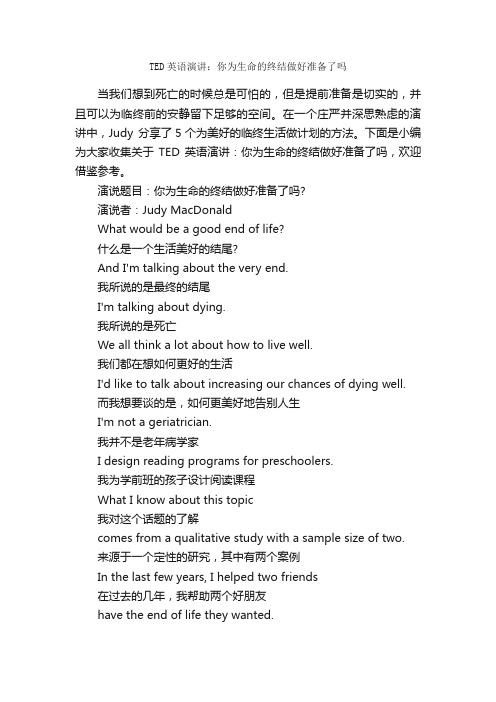
TED英语演讲:你为生命的终结做好准备了吗当我们想到死亡的时候总是可怕的,但是提前准备是切实的,并且可以为临终前的安静留下足够的空间。
在一个庄严并深思熟虑的演讲中,Judy 分享了5个为美好的临终生活做计划的方法。
下面是小编为大家收集关于TED英语演讲:你为生命的终结做好准备了吗,欢迎借鉴参考。
演说题目:你为生命的终结做好准备了吗?演说者:Judy MacDonaldWhat would be a good end of life?什么是一个生活美好的结尾?And I'm talking about the very end.我所说的是最终的结尾I'm talking about dying.我所说的是死亡We all think a lot about how to live well.我们都在想如何更好的生活I'd like to talk about increasing our chances of dying well.而我想要谈的是,如何更美好地告别人生I'm not a geriatrician.我并不是老年病学家I design reading programs for preschoolers.我为学前班的孩子设计阅读课程What I know about this topic我对这个话题的了解comes from a qualitative study with a sample size of two.来源于一个定性的研究,其中有两个案例In the last few years, I helped two friends在过去的几年,我帮助两个好朋友have the end of life they wanted.以他们想要的方式,结束了他们的生命Jim and Shirley Modini spent their 68 years of marriage Jim 和 Shirley Modini度过了他们68年的婚姻生活living off the grid on their 1,700-acre ranch生活在远离城镇的,1,700英亩的牧场里in the mountains of Sonoma County. Sonoma县的山区They kept just enough livestock to make ends meet他们喂养了仅仅是能养活他们自己的家禽so that the majority of their ranch would remain a refuge所以这大部分的牧场变成了避难所for the bears and lions and so many other things给熊,狮子和其他的动物that lived there.生活在那里This was their dream.这正是他们的梦想I met Jim and Shirley in their 80s.我在两个老人年迈八十的时候遇见他们They were both only children who chose not to have kids. 他们只有一个子女,而他选择不要孩子As we became friends, I became their trustee当我们成为朋友后,我变成了他们的托管人and their medical advocate,与他们的医疗顾问but more importantly, I became但是更重要的是the person who managed their end-of-life experiences.我成为了帮助他们结束生活的那个人And we learned a few things about how to have a good end.并且我们学到了,如何有个好的结局In their final years, Jim and Shirley在最后的几年里, Jim和 Shirleyfaced cancers, fractures, infections, neurological illness.他们面对着癌症,骨折,传染病和神经上上的疾病It's true.这是真的At the end, our bodily functions人到了最后,我们身体的功能and independence are declining to zero.和独立性会降低到零What we found is that, with a plan and the right people,我们发现,如果有正确的计划和人quality of life can remain high.他们还是可以拥有高品质的生活The beginning of the end is triggered结束的开始是被其他所引起的by a mortality awareness event, and during this time,像对死亡的意识,并且在此期间Jim and Shirley chose ACR nature preserves Jim和 Shirley选择了ACR自然保护区to take their ranch over when they were gone.在他们去世后接手牧场This gave them the peace of mind to move forward.这给了他们一片祥和,然后继续前行It might be a diagnosis. It might be your intuition.这可能是个诊断,也可能是你的直觉But one day, you're going to say, "This thing is going to get me."有一天,你会说,这样的事情会打垮我Jim and Shirley spent this time Jim和Shirley用这些时间letting friends know that their end was near让他们的朋友知道,离他们离开人世的时间不远了and that they were okay with that.而他们对此没有埋怨Dying from cancer and dying from neurological illness因为患癌症与神经疾病而死去are different.是不一样的In both cases, last days are about quiet reassurance.两种情况,最后的几天都非常安详Jim died first. He was conscious until the very end, Jim先离去,到最后他都非常的清醒but on his last day he couldn't talk.但是在他最后一天,他说不了话Through his eyes, we knew when he needed to hear again, 通过他的眼睛,我们知道当他想听我们说话"It is all set, Jim. We're going to take care of Shirley“什么都很好,Jim。
ted演讲稿中英文对照
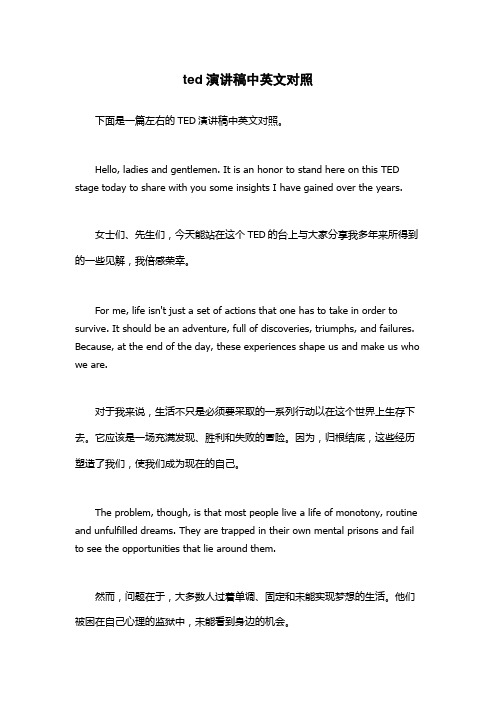
ted演讲稿中英文对照下面是一篇左右的TED演讲稿中英文对照。
Hello, ladies and gentlemen. It is an honor to stand here on this TED stage today to share with you some insights I have gained over the years.女士们、先生们,今天能站在这个TED的台上与大家分享我多年来所得到的一些见解,我倍感荣幸。
For me, life isn't just a set of actions that one has to take in order to survive. It should be an adventure, full of discoveries, triumphs, and failures. Because, at the end of the day, these experiences shape us and make us who we are.对于我来说,生活不只是必须要采取的一系列行动以在这个世界上生存下去。
它应该是一场充满发现、胜利和失败的冒险。
因为,归根结底,这些经历塑造了我们,使我们成为现在的自己。
The problem, though, is that most people live a life of monotony, routine and unfulfilled dreams. They are trapped in their own mental prisons and fail to see the opportunities that lie around them.然而,问题在于,大多数人过着单调、固定和未能实现梦想的生活。
他们被困在自己心理的监狱中,未能看到身边的机会。
I was one of those people, until I decided to break free from my own limitations and pursue my dreams. It wasn't an easy journey, but it was worth it. The lessons I learned along the way have helped me to become a better person, a better writer and a better human being.我曾经是其中之一,直到我决定打破我的限制,追逐我的梦想。
2023励志_ted演讲稿中英对照励志
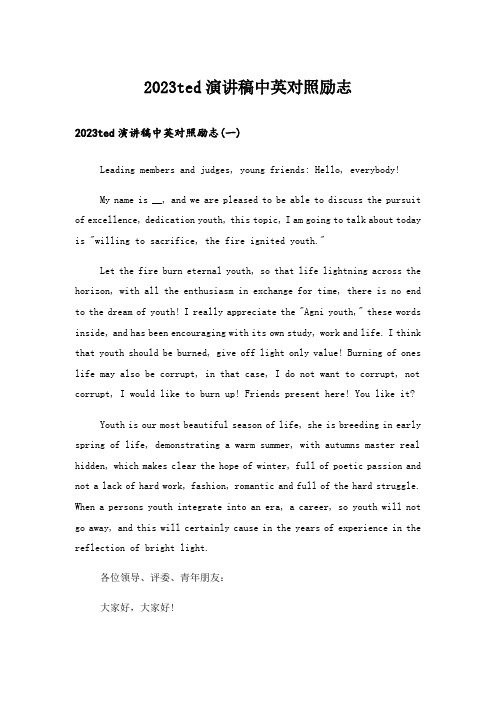
2023ted演讲稿中英对照励志2023ted演讲稿中英对照励志(一)Leading members and judges, young friends: Hello, everybody!My name is __, and we are pleased to be able to discuss the pursuit of excellence, dedication youth, this topic, I am going to talk about today is "willing to sacrifice, the fire ignited youth."Let the fire burn eternal youth, so that life lightning across the horizon, with all the enthusiasm in exchange for time, there is no end to the dream of youth! I really appreciate the "Agni youth," these words inside, and has been encouraging with its own study, work and life. I think that youth should be burned, give off light only value! Burning of ones life may also be corrupt, in that case, I do not want to corrupt, not corrupt, I would like to burn up! Friends present here! You like it?Youth is our most beautiful season of life, she is breeding in early spring of life, demonstrating a warm summer, with autumns master real hidden, which makes clear the hope of winter, full of poetic passion and not a lack of hard work, fashion, romantic and full of the hard struggle. When a persons youth integrate into an era, a career, so youth will not go away, and this will certainly cause in the years of experience in the reflection of bright light.各位领导、评委、青年朋友:大家好,大家好!我的名字是某某,我们很高兴能够讨论追求卓越,奉献青春,这一主题,我今天要谈的是“愿意牺牲,火灾点燃青年。
麦戈尼克尔ted演讲内容
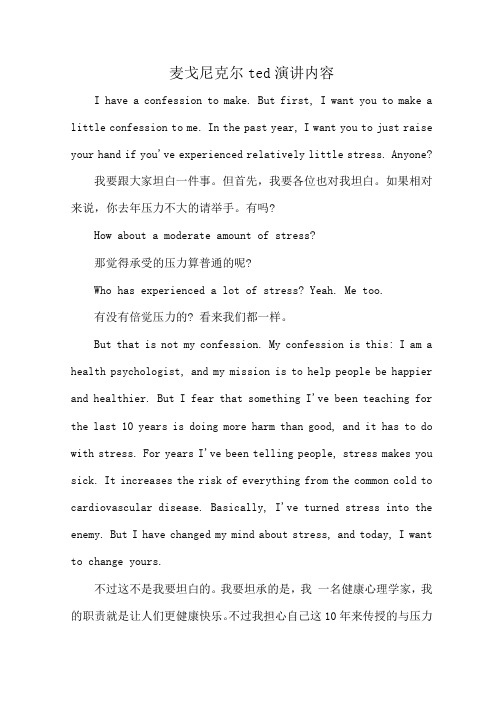
麦戈尼克尔ted演讲内容I have a confession to make. But first, I want you to make a little confession to me. In the past year, I want you to just raise your hand if you've experienced relatively little stress. Anyone?我要跟大家坦白一件事。
但首先,我要各位也对我坦白。
如果相对来说,你去年压力不大的请举手。
有吗?How about a moderate amount of stress?那觉得承受的压力算普通的呢?Who has experienced a lot of stress? Yeah. Me too.有没有倍觉压力的? 看来我们都一样。
But that is not my confession. My confession is this: I am a health psychologist, and my mission is to help people be happier and healthier. But I fear that something I've been teaching for the last 10 years is doing more harm than good, and it has to do with stress. For years I've been telling people, stress makes you sick. It increases the risk of everything from the common cold to cardiovascular disease. Basically, I've turned stress into the enemy. But I have changed my mind about stress, and today, I want to change yours.不过这不是我要坦白的。
ted演讲《在我死前,我想...》
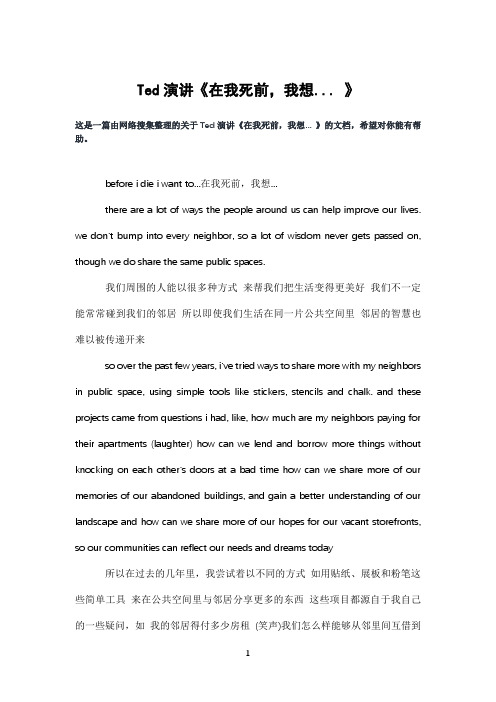
Ted演讲《在我死前,我想... 》这是一篇由网络搜集整理的关于Ted演讲《在我死前,我想... 》的文档,希望对你能有帮助。
before i die i want to...在我死前,我想...there are a lot of ways the people around us can help improve our lives. we don't bump into every neighbor, so a lot of wisdom never gets passed on, though we do share the same public spaces.我们周围的人能以很多种方式来帮我们把生活变得更美好我们不一定能常常碰到我们的邻居所以即使我们生活在同一片公共空间里邻居的智慧也难以被传递开来so over the past few years, i've tried ways to share more with my neighbors in public space, using simple tools like stickers, stencils and chalk. and these projects came from questions i had, like, how much are my neighbors paying for their apartments (laughter) how can we lend and borrow more things without knocking on each other's doors at a bad time how can we share more of our memories of our abandoned buildings, and gain a better understanding of our landscape and how can we share more of our hopes for our vacant storefronts, so our communities can reflect our needs and dreams today所以在过去的几年里,我尝试着以不同的方式如用贴纸、展板和粉笔这些简单工具来在公共空间里与邻居分享更多的东西这些项目都源自于我自己的一些疑问,如我的邻居得付多少房租(笑声)我们怎么样能够从邻里间互借到更多的东西同时避免在不合时宜的时候敲开对方的门我们怎样能够更好地分享各自的关于被毁弃的建筑的回忆并更好地理解我们居住的这片土地怎样更能表达我们对空置的店面的期待使我们的社区能反映出我们现在的需求和梦想now, i live in new orleans, and i am in love with new orleans. my soul is always soothed by the giant live oak trees, shading lovers, drunks and dreamers for hundreds of years, and i trust a city that always makes way for music. (laughter) i feel like every time someone sneezes, new orleans has a parade. (laughter) the city has some of the most beautiful architecture in the world, but it also has one of the highest amounts of abandoned properties in america.我现时住在新奥尔良并深深地爱上了这座城市那些生生不息的巨型橡树总是可以抚慰我的灵魂几百年来,情侣、醉汉和追梦人们总会稍息在树影下我深信这一座充满着音乐律动的城市每当有人打喷嚏时,我都感觉新奥尔良来了一只游行队伍(笑声) 新奥尔良拥有世界上很多最漂亮的建筑但同时,她也是全美拥有最多废弃建筑的城市i live near this house, and i thought about how i could make it a nicer space for my neighborhood, and i also thought about something that changed my life forever.我住在这栋房子附近,我就想如何让它在这片社区里成为一个更好的地方也思考了另一件事这件事彻底改变了我的人生。
瞄准你的生命终点英语作文
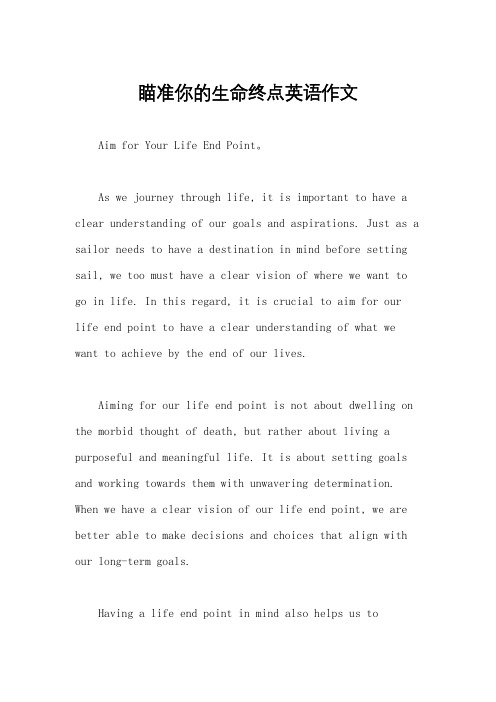
瞄准你的生命终点英语作文Aim for Your Life End Point。
As we journey through life, it is important to have a clear understanding of our goals and aspirations. Just as a sailor needs to have a destination in mind before setting sail, we too must have a clear vision of where we want to go in life. In this regard, it is crucial to aim for our life end point to have a clear understanding of what we want to achieve by the end of our lives.Aiming for our life end point is not about dwelling on the morbid thought of death, but rather about living a purposeful and meaningful life. It is about setting goals and working towards them with unwavering determination. When we have a clear vision of our life end point, we are better able to make decisions and choices that align with our long-term goals.Having a life end point in mind also helps us toprioritize what truly matters to us. It allows us to focus on the things that bring us joy and fulfillment, and to let go of the things that are inconsequential in the grand scheme of our lives. By aiming for our life end point, we are able to live with intention and purpose, making the most of every moment and opportunity that comes our way.In aiming for our life end point, it is important to consider not just our personal achievements, but also the impact we want to have on the world around us. What legacy do we want to leave behind? How do we want to be remembered by those whose lives we have touched? These are important questions to consider as we strive towards our life end point.Setting a life end point also helps us to overcome the fear of failure and the uncertainty of the future. When we have a clear vision of where we want to be at the end of our lives, we are better able to navigate the challenges and setbacks that come our way. We are able to stay focused on our long-term goals, and to persevere in the face of adversity.In conclusion, aiming for our life end point is about living with purpose, intention, and determination. It is about setting goals, making choices, and living in a waythat aligns with our long-term aspirations. By having aclear vision of our life end point, we are able to live alife that is meaningful, fulfilling, and true to who we are. So, let us aim for our life end point, and make the most of the journey that lies ahead.。
- 1、下载文档前请自行甄别文档内容的完整性,平台不提供额外的编辑、内容补充、找答案等附加服务。
- 2、"仅部分预览"的文档,不可在线预览部分如存在完整性等问题,可反馈申请退款(可完整预览的文档不适用该条件!)。
- 3、如文档侵犯您的权益,请联系客服反馈,我们会尽快为您处理(人工客服工作时间:9:00-18:30)。
在生命的尽头你想要什么TED英语演讲稿带翻译WTT收集整理的在生命的尽头你想要什么TED英语演讲稿带翻译,欢迎阅读,希望大家能够喜欢。
Well, we all need a reason to wake up. For me, it just took 11,000 volts.I know you're too polite to ask, so I will tell you.One night, sophomore year of college, just back from Thanksgiving holiday, a few of my friends and I were horsing around, and we decided to climb atop a parked muter train. It was just sitting there, with the wires that run overhead. Somehow, that seemed like a great idea at the time. We'd certainly done stupider things. I scurried up the ladder on the back, and when I stood up, the electrical current entered my arm, blew down and out my feet, and that was that. Would you believe that watch still works? Takes a licking!My father wears it now in solidarity.That night began my formal relationship with death —— my death —— and it also began my long run as apatient. It's a good word. It means one who suffers. So I guess we're all patients.Now, the American health care system has more than its fair share of dysfunction —— to match its brilliance, to be sure. I'm a physician now, a hospice and palliative medicine doc, so I've seen care from both sides. And believe me: almost everyone who goes into healthcare really means well —— I mean, truly. But we who work in it are also unwitting agents for a systemthat too often does not serve.Why? Well, there's actually a pretty easy answer to that question, and it explains a lot: because healthcare was designed with diseases, not people, at its center. Which is to say, of course, it was badly designed. And nowhere are the effects of bad design more heartbreaking or the opportunity for good design more pelling than at the end of life, where things are so distilled and concentrated. There are no do—overs.My purpose today is to reach out across disciplines and invite design thinking into this big conversation. That is, to bring intention and creativity to the experience of dying. We have a monumental opportunity infront of us, before one of the few universal issues as individuals as well as a civil society: to rethink and redesign how it is we die.So let's begin at the end. For most people, the scariest thing about death isn't being dead, it's dying, suffering. It's a key distinction. To get underneath this, it can be very helpful to tease out suffering which is necessary as it is, from suffering we can change. The former is a natural, essential part of life, part of the deal, and to this we are called to make space, adjust, grow. It can be really good to realize forces larger than ourselves. They bring proportionality, like a cosmic right—sizing. After my limbs were gone, that loss, for exle, became fact,fixed —— necessarily part of my life, and I learned that I could no more reject this fact than reject myself. It took me a while, but I learned it eventually. Now,another great thing about necessary suffering is that it is the very thing that unites caregiver and care receiver —— human beings. This, we are finally realizing, is where healing happens. Yes, passion —— literally, as we learned yesterday —— suffering together.Now, on the systems side, on the other hand, so much of the suffering is unnecessary, invented. It serves no good purpose. But the good news is, since this brand of suffering is made up, well, we can change it. How we die is indeed something we can affect. Making the system sensitive to this fundamental distinction between necessary and unnecessary suffering gives us our first of three design cues for the day. After all, our role as caregivers, as people who care, is to relieve suffering —— not add to the pile.True to the tes of palliative care, I function as something of a reflective advocate, as much as prescribing physician. Quick aside: palliative care ——a very important field but poorly understood —— while it includes, it is not limited to end of life care. Itis not limited to hospice. It's simply about fort and living well at any stage. So please know that you don't have to be dying anytime soon to benefit from palliative care.Now, let me introduce you to Frank. Sort of makes this point. I've been seeing Frank now for years. He's living with advancing prostate cancer on top of long—standing HIV. We work on his bone pain and his fatigue,but most of the time we spend thinking out loud together about his life —— really, about our lives. In this way, Frank grieves. In this way, he keeps up with his losses as they roll in, so that he's ready to take in the next moment. Loss is one thing, but regret, quite another. Frank has always been an adventurer —— he looks like something out of a Norman Rockwell painting —— and no fan of regret. So it wasn't surprising when he came into clinic one day, saying he wanted to raft down the Colorado River. Was this a good idea? With all the risks to his safety and his health, some would say no. Many did, but he went for it, while he still could. It was a glorious, marvelous trip: freezing water,blistering dry heat, scorpions, snakes, wildlife howling off the flaming walls of the Grand Canyon ——all the glorious side of the world beyond our control. Frank's decision, while maybe dramatic, is exactly the kind so many of us would make, if we only had the support to figure out what is best for ourselves over time.So much of what we're talking about today is a shiftin perspective. After my accident, when I went back to college, I changed my major to art history. Studying visual art, I figured I'd learn something about how to see —— a really potent lesson for a kid who couldn't change so much of what he was seeing. Perspective, that kind of alchemy we humans get to play with, turning anguish into a flower.Flash forward: now I work at an amazing place in San Francisco called the Zen Hospice Project, where we havea little ritual that helps with this shift in perspective. When one of our residents dies, the mortuary men e, and as we're wheeling the body out through the garden,heading for the gate, we pause. Anyone who wants ——fellow residents, family, nurses, volunteers, the hearse drivers too, now —— shares a story or a song or silence, as we sprinkle the body with flower petals. It takes a few minutes; it's a sweet, simple parting image to usher in grief with warmth, rather than repugnance. Contrast that with the typical experience in the hospital setting, much like this —— floodlit room lined with tubes and beeping machines and blinking lights that don'tstop even when the patient's life has. Cleaning crew swoops in, the body's whisked away, and it all feels as though that person had never really existed. Well—intended, of course, in the name of sterility, but hospitals tend to assault our senses, and the most we might hope for within those walls is numbness ——anesthetic, literally the opposite of aesthetic. Irevere hospitals for what they can do; I am alive because of them. But we ask too much of our hospitals. They are places for acute trauma and treatable illness. They are no place to live and die; that's not what they were designed for.Now mind you —— I am not giving up on the notionthat our institutions can bee more humane. Beauty can be found anywhere. I spent a few months in a burn unit at St. Barnabas Hospital in Livingston, New Jersey, where Igot really great care at every turn, including good palliative care for my pain. And one night, it began to snow outside. I remember my nurses plaining about driving through it. And there was no window in my room, but it was great to just imagine it ing down all sticky. Next day, one of my nurses smuggled in a snowball for me. Shebrought it in to the unit. I cannot tell you the raptureI felt holding that in my hand, and the coldnessdripping onto my burning skin; the miracle of it all,the fascination as I watched it melt and turn into water. In that moment, just being any part of this pla in this universe mattered more to me than whether I lived or died. That little snowball packed all the inspiration I neededto both try to live and be OK if I did not. In ahospital, that's a stolen moment.In my work over the years, I've known many peoplewho were ready to go, ready to die. Not because they had found some final peace or transcendence, but becausethey were so repulsed by what their lives had bee —— in a word, cut off, or ugly. There are already record numbers of us living with chronic and terminal illness,and into ever older age. And we are nowhere near ready or prepared for this silver tsunami. We need aninfrastructure dynamic enough to handle these seismicshifts in our population. Now is the time to create something new, something vital. I know we can because we have to. The alternative is just unacceptable. And thekey ingredients are known: policy, education andtraining, systems, bricks and mortar. We have tons of input for designers of all stripes to work with.We know, for exle, from research what's most important to people who are closer to death: fort;feeling unburdened and unburdening to those they love;existential peace; and a sense of wonderment and spirituality.Over Zen Hospice's nearly 30 years, we've learned much more from our residents in subtle detail. Little things aren't so little. Take Jate. She finds it harder to breathe one day to the next due to ALS. Well, guess what? She wants to start smoking again —— and French cigarettes, if you please. Not out of some self—destructive bent, but to feel her lungs filled while she has them. Priorities change. Or Kate —— she just wants to know her dog Austin is lying at the foot of her bed,his cold muzzle against her dry skin, instead of more chemotherapy coursing through her veins —— she's done that. Sensuous, aesthetic gratification, where in a moment, in an instant, we are rewarded for just being. So much of it es down to loving our time by way of thesenses, by way of the body —— the very thing doing the living and the dying.Probably the most poignant room in the Zen Hospice guest house is our kitchen, which is a little strange when you realize that so many of our residents can eat very little, if anything at all. But we realize we are providing sustenance on several levels: smell, a symbolic plane. Seriously, with all the heavy—dutystuff happening under our roof, one of the most tried and true interventions we know of, is to bake cookies. As long as we have our senses —— even just one —— we have at least the possibility of accessing what makes us feel human, connected. Imagine the ripples of this notion for the millions of people living and dying with dementia. Primal sensorial delights that say the things we don't have words for, impulses that make us stay present —— no need for a past or a future.So, if teasing unnecessary suffering out of the system was our first design cue, then tending to dignity by way of the senses, by way of the body —— the aesthetic realm —— is design cue number two. Now this gets us quickly to the third and final bit for today;namely, we need to lift our sights, to set our sights on well—being, so that life and health and healthcare can bee about making life more wonderful, rather than just less horrible. Beneficence.Here, this gets right at the distinction between a disease—centered and a patient— or human—centered model of care, and here is where caring bees acreative, generative, even playful act. "Play" may sound like a funny word here. But it is also one of our highest forms of adaptation. Consider every major pulsory effort it takes to be human. The need for food hasbirthed cuisine. The need for shelter has given rise to architecture. The need for cover, fashion. And for being subjected to the clock, well, we invented music. So,since dying is a necessary part of life, what might we create with this fact? By "play" I am in no way suggesting we take a light approach to dying or that we mandate any particular way of dying. There are mountains of sorrow that cannot move, and one way or another, we will all kneel there. Rather, I am asking that we make space —— physical, psychic room, to allow life to play itself all the way out —— so that rather than justgetting out of the way, aging and dying can bee a process of crescendo through to the end. We can't solve for death. I know some of you are working on this.Meanwhile, we can ——We can design towards it. Parts of me died early on,and that's something we can all say one way or another. I got to redesign my life around this fact, and I tell you it has been a liberation to realize you can always find a shock of beauty or meaning in what life you have left,like that snowball lasting for a perfect moment, all the while melting away. If we love such moments ferociously,then maybe we can learn to live well —— not in spite of death, but because of it. Let death be what takes us,not lack of imagination.Thank you.中文演讲稿我们都需要一个醒来的理由。
